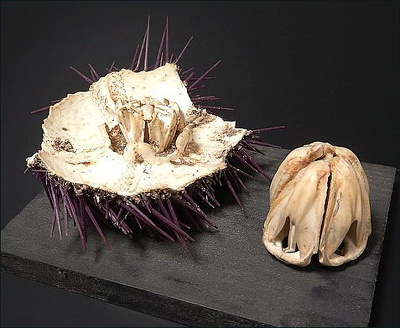Home | Category: Coral Reef Life / Jellyfish, Sponges, Sea Urchins and Anemones
SEA URCHINS
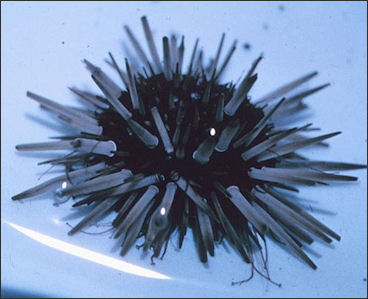 Sea urchins are small round sea creatures with a hard shell surrounded by spines. They are echinoderms like starfish, sea anemones and sea cucumbers but are different from sea anemones, which are small marine animals with a tubular body and circles of tentacles. The word "urchin is derived from the Old French term for "hedgehog."
Sea urchins are small round sea creatures with a hard shell surrounded by spines. They are echinoderms like starfish, sea anemones and sea cucumbers but are different from sea anemones, which are small marine animals with a tubular body and circles of tentacles. The word "urchin is derived from the Old French term for "hedgehog."
Sea urchins have been called he porcupines of the sea. Most species of sea urchins have long spike-like spines that protect them from predators such fish, crabs, turtles and other sea creatures that like to feed on their soft undersides. Sea urchin spines are mounted on hinges and can be moved around. Scattered among the spines are finger-like appendages that pick and remove dirt and other foreign material.
Sea urchins help the ecosystems they live in creating habitat and fostering biodegradation. They are considered a keystone species, meaning their presence or absence strongly affects populations of other species in area where they live. Sea urchins play a key role as “lawnmowers” of the reef, eating up the algae that grows on corals. If sea urchins die or disappear algae can cover a reef and smother the corals.
Sea urchin studies provided the first evidence of actin in non-muscle cells. Actin is a family of globular multi-functional proteins that form microfilaments in the cytoskeleton, and the thin filaments in muscle fibrils. Sea urchin eggs are used extensively in embryological research. For many years, Dr. William Speck, Chairman and Director of the Department of Pediatrics of Case Western Reserve University, has studied the causes of birth defects using Arbacia punctulata sea urchins as his primary subject. Among the things he studied using sea urchin were the effects of ethanol, fetal alcohol syndrome, the effects of anticonvulsant drugs and the development of phenytoin derivatives.
[Source: Stephanie Braccini, Animal Diversity Web (ADW) /=]
Related Articles: JELLYFISH, SPONGES, SEA URCHINS AND ANEMONES ioa.factsanddetails.com; ECHINODERMS (SEA STARS, SEA CUCUMBERS AND SEA URCHINS): CHARACTERISTICS, BEHAVIOR, REPRODUCTION ioa.factsanddetails.com SEA ANEMONES: CHARACTERISTICS, FEEDING AND TOXINS ioa.factsanddetails.com ; SEA URCHIN TYPES AND SPECIES ioa.factsanddetails.com ; CORAL REEFS ioa.factsanddetails.com ; CORAL REEF LIFE ioa.factsanddetails.com REEF FISH ioa.factsanddetails.com
Websites and Resources: Animal Diversity Web (ADW) animaldiversity.org; National Oceanic and Atmospheric Administration (NOAA) noaa.gov; Fishbase fishbase.se; Encyclopedia of Life eol.org; Smithsonian Oceans Portal ocean.si.edu/ocean-life-ecosystems ; Monterey Bay Aquarium montereybayaquarium.org ; MarineBio marinebio.org/oceans/creatures; Websites and Resources on Coral Reefs: Coral Reef Information System (NOAA) coris.noaa.gov ; International Coral Reef Initiative icriforum.org ; Coral Reef Alliance coral.org ; Global Coral reef Alliance globalcoral.org ; Global Coral Reef Monitoring Network gcrmn.net
Echinoderms
Echinoderms (meaning "spiny skinned") are a phylum of animals that includes sea urchins, starfish and sea cucumbers. They are invertebrates with no head. Their internal organs — and often their outer organs — are arranged in five symmetrical parts around a central stomach. The creatures have no front or back. Humans and other mammals are bilaterally symmetrical with nearly identical left and right sides and distinct front and backs.
There are around 7,000 different species of echinoderm. Most echinoderms have tough skins and flexible spines and/or tube feet. They also have unique groups of hydraulic organs that serve several functions and work in conjunction with muscles to power the tube feet.
Echinoderms “do not have a ‘heart’ or anything analogous to it,” Chris Mah, a marine invertebrate zoologist at the Smithsonian National Museum of Natural History in Washington, told National Geographic. They don’t have blood either. Instead, they have millions of tiny, hairlike structures called cilia that beat constantly, pumping seawater via “a system of internal pipes and bags,” Mah says. Their internal cavity also has “all the various cells needed for transporting nutrients, immune cells, and so forth.” [Source: Liz Langley, National Geographic, February 13, 2016]
See Separate Article ECHINODERMS ioa.factsanddetails.com
Sea Urchin Characteristics
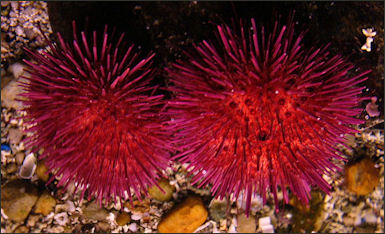
The sea urchin;s body area is called a test. It is made up of fused plates that encircle the urchin. Each of the plates have small holes from which the feet extend. These feet are controlled by an internal water vascular system. This system works by varying the amount of water inside the system which controls the feet by extending or contracting them. They have a mouth at the underside and an anus at the top of the animal.
A sea urchins five teeth are not only consume prey they also grind away limestone to produce a niche depression for the creature to settle into. How do teeth made of calcium grind down rock also made of calcium without being worn down. Scientists at the University of Wisconsin, using powerful high-resolution X-ray technology to investigate this problem, found the teeth are formed into needle-like crystal-like matrixes and have a bit of magnesium in them that make them harder.
Sea urchins sense using vision, touch and chemicals usually detected with smell and communicate with touch and chemicals usually detected by smelling. They also employ pheromones (chemicals released into air or water that are detected by and responded to by other animals of the same species. According to Animal Diversity Web: Rock-boring urchins communicate with members of their own species through tactile means, using their tube feet and spines and, when spawning, through chemical signals. It is also able to detect shadows and chemicals released by its predators. Although they have no discrete visual organs, urchins have been found to express vision related genes in their tube feet. It has also been found that their spines filter light from wide angles, allowing them to detect relatively fine visual detail (species with densely packed spines have greater acuity than those with widely spaced spines). [Source: Julio Plazas, Animal Diversity Web (ADW) /=]
Aristotle's Lantern
Sea urchins have a unique structure called Aristotle's lantern for a mouth. It is made of five hard plates that move together like a beak and has a muscular system comprised of a powerful set of jaws. The five sharp teeth-like structures of the beak can move in various directions. Sea urchins use their beak-like structure to scrape rocks clean of algae. This maneuverability of the teeth allows them to graze on all sorts of algae growing within the nooks and crannies of a rocky reef environment. These 'teeth' can also grow back after too much wear.
How did this jaw system end up with Aristotle’s name. Aristotle (384-322 B.C.) was the first man to carefully examine a sea urchin. He noticed unique resemblance between horn lanterns of his time and sea urchins. These lanterns, a common source in ancient times, consisted of five window panes. The the mouth of a sea urchin reminded Aristotle of the lantern's five-part structure. "The urchin has of hollow teeth inside," Aristotle wrote, "and in the middle of these a fleshy substance serving the office of a tongue...The mouth-apparatus of the urchin is continuous from one end to the other, but to outward appearance it is not so, but looks like a horn lantern with the panes of horn left out." The sea urchin mouth was later named Aristotle' Lantern in his honor.
Research has been done on the Aristotle's Lantern, specifically the dental ligaments (collogen strands that attach the teeth to the jaw) because they periodically change stiffness in different ionic concentrations. These ligaments are similar to the periodontal ligaments found in humans.
Sea Urchins Have No Eyes and See with Their Feet
Elizabeth Preston wrote in Discover magazine: Threaten a sea urchin, and you may see it point its spines at you. This defensive response is pretty unremarkable — except for the fact that, is you look closer, you will not see the sea urchin's eyes. It doesn't have any. Sea urchins are the only animals that have vision despite "conspicuously lacking eyes," write Dan-Eric Nilsson, a biologist at the University of Lund in Sweden who studies animal vision, and his colleagues. In a new study, the researchers gave the spiny sea creatures a kind of eyeless eye exam to find out how good their vision is. They concluded that the animals have pretty poor eyesight, and that it's actually foot-sight. "I think the term 'tube feet' may be a little misleading," Nilsson says. A 2011 study of purple sea urchins (Strongylocentrotus purpuratus) found that the animals' tube feet, strangely, have light-sensitive cells at their bases. Perhaps, the authors wrote, "The entire sea urchin...functions as a huge compound eye."
In the 2018 study, researchers followed up on this idea by studying long-spined sea urchins (Diadema africanum). They placed the urchins one at a time in the center of a cylindrical tank. Against the wall of this "arena," the researchers displayed printed images — either a simple black bar, or a pattern of black, white and gray. They used images of different widths like the rows in an eye chart, to test how well the animals could see. In another set of experiments, a monitor directly above the sea urchins displayed black circles of different sizes, like looming predators. In some cases, the sea urchins moved toward the dark images on the tank walls. This behavior could help urchins in the wild to find shelter when they're exposed on the seafloor, or to find other urchins and cluster for safety. When an object loomed overhead, alarmed urchins sometimes pointed their spines at it. Based on which images prompted a response, the researchers found that sea urchin vision isn't great. Of the 360 degrees around an urchin, an object has to take up somewhere between 30 and 70 degrees before the urchin can see it. Humans can see things at more like 1/60th of a degree, Nilsson says. "This means that the sea urchin's picture of the world is very crude in human standards," Nilsson says. "But it is good enough to guide movements towards suitable structures in their environment." [Source:Elizabeth Preston, Discover, May 30, 2018]
The researchers also examined the bodies of long-spined sea urchins up close to see where their tube feet are. Then they estimated the angles at which light hits the feet. They calculated what resolution the animal's vision would have if all its feet — hundreds in every direction, Nilsson says — worked together as a kind of giant compound eye. The visual acuity that urchins showed in the tank experiments was within the range that scientists estimated from the tube-foot model. In other words, the animals do seem to see with their feet. A sea urchin is one big, spine-covered eyeball. Its vision might not impress an eye doctor, but for an animal with no actual eyes, it's not bad.
Sea Urchin Feeding, Movement and Behavior
Sea urchins have tube feet on their undersides like star fish except they are generally longer. The tube feet have three main functions: 1) they help they animal move with powerful suction that grasps onto things and muscles that expand and retract; 2) they can take in oxygen from the seawater and serve as gills; and 3) they are packed with sensory neurons and help the animal sense its surroundings.
Elizabeth Preston wrote in Discover magazine: Sea urchins are shaped like squashed spheres, with a hard shell covered in spines. Interspersed among the spines are holes that hide tentacle-like objects called tube feet. But only the feet on the urchin's underside are for walking. The urchin uses the rest of its tube feet for tasks like attaching to surfaces, flipping itself upright when it gets turned over, and keeping clean. [Source: Elizabeth Preston, Discover, May 30, 2018]
Sea urchins usually stay in one place during the day, often in niche or a a crevice. They use their tube feet to attach themselves to rocky surfaces. Some have the ability to eat away at rock and create their own burrows. Most movements occur during dark hours, when urchins move out of crevices and rock burrows to feed.
At night after they emerge from their hiding places, sea urchins roam the reef grazing on blue-green algae that quickly accumulates. They move slowly across the sea floor, reefs and boulders, consuming algae on their underside with their Aristotle's lantern — a mouth sort of like the jaws that grasp a bit in a drill. Sea urchins feed by scraping off the surface of algae-encrusted rocks and feeding the algae to the elaborate jaw mechanism in their Aristotle's lantern.
Sea Urchin Mating and Reproduction
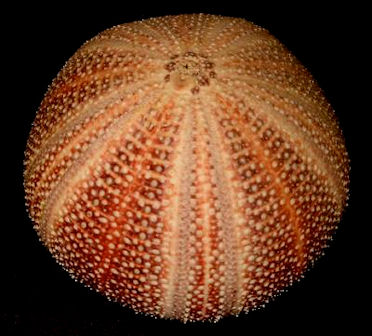
dead sea urchin's test, without its spines Sea urchins are oviparous (young are hatched from eggs) and iteroparous (offspring are produced in groups). They are dioecious (male and female reproductive organs are in separate individuals) rather than hermaphrodites and engage in external reproduction in which sperm from the male fertilizes the female’s egg outside her body. There is pre-fertilization provisioning but no parental involvement after spawning. [Source: Stephanie Braccini, Animal Diversity Web (ADW) /=]
Sea urchins engage in seasonal breeding and spawning is often dependent on temperature . The spawning of long-spined sea urchins appears to be connected to the lunar calendar. During the summer season, the egg and sperm are released once during each lunar month. This spawning period is dependent upon temperature; populations in different hemispheres may spawn at different times depending on when the warm season occurs.
Distinguishing male and female sea urchins is near impossible except when they are spawning. Observations of spawning are quite rare. The male releases a cloud of smoky white sperm and the female releases a cloud of creamy eggs. The releases look like miniature volcanic eruptions.
Sea urchins produce a great number of small eggs. The egg are surrounded by a protective covering, which in turn are covered by a layer of jelly. In the early stages of fertilization, the sperm attaches itself to the jelly. Chemical signals cause the protective covering to rupture and allow the sperm to fertilize the egg. Most of the eggs and the larvae that emerge from them are eaten by sea anemones and other creatures. A few drift and settle some place long enough to grow into adults.
Sea Urchins Development
The life cycle of sea urchins is characterized by metamorphosis — a process of development in which individuals change in shape or structure as they grow. According to Animal Diversity Web: The fertilized egg has two forms: the blastula and the gastrula. These swim close to the surface of the water with the aid of cilia, and can be dispersed quite far, depending on currents. These larvae are known as the echinopluteus, and can remain in the larval stage for an average of 4-6 weeks. [Source: Stephanie Braccini, Animal Diversity Web (ADW) /=]
As the larvae mature, a vestibule is created in what will be the oral side of the urchin. Tentacles grow from this opening, on which suction areas eventually emerge. When the tentacles have suckers, they are primary poda, which serve as locomotive tools when the larva sinks to the ocean floor. At this point the skeletal plates begin to develop. When the five ambulical plates are developed and the terminal plate lies next to the genital plates, the urchin is fully developed, though it will continue to grow for the rest of its life. /=\
Among rock-boring urchins, according to Animal Diversity Web, Post-fertilization, zygotes undergo first cleavage after approximately 90 minutes. Planktonic larvae develop in several stages, including the blastula (reached at the 128 cell stage), gastrula (1000 cell stage), and prism stages. The following stage, four-armed pluteus, is reached after the second day of fertilization. Following the fourth day, posterodorsal arms appear and full metamorphosis occurs approximately 19 days after fertilization. This urchin is a slow-growing and relatively long-lived echinoid species with a life expectancy over 10 years. [Source: Julio Plazas, Animal Diversity Web (ADW) /=]
Sea Urchins and Other Sea Creatures
Many sea stars feed on sea urchins. Sea urchins, if not controlled by predators, may overgraze their habitat. Most rock-boring urchins relationships are commensal. Some goby and clingfish species, as well as crustaceans, reside within its spines for protection. It is, however, also host to at least two species of ectoparasitic copepods Sea urchins that look like they trapped inside a small localized blizzard are in fact surrounded by hundreds of tiny shrimp in the process of laying their eggs.
In many places, sea otters prey mainly on sea urchins. Pufferfish brave the urchin's spines to get at their soft undersides. Triggerfish feed on sea urchins by first blowing a jet of water on the urchin to turn it upside down. Avoiding the short spins on the underside the skilled predator pecks away at the urchin's shell with its beak-like mouth to get at the urchin's fleshy interior.
The purple sea urchin has a symbiotic relationship with small grooming organisms that live between their spines. At first these organisms were thought to be parasites, feeding off of the food floating by the urchin. But it was later discovered that the organism were an integral part of the sea urchin's care by keeping its surface free from other harmful animals or plants [Source: Stephanie Braccini, Animal Diversity Web (ADW) /=]
Massive Die Off of Sea Urchins in the Caribbean
Around Panama in the 1970s, sea urchins died of so some unknown reason and algae took over reefs, killing large amounts of coral. In 1983 Long-spined sea urchins experienced a massive die-off all across the Caribbean. Some areas lost up to 97 percent of mature individuals. The die-off is thought to be due to a water-borne pathogen that was never identified. The reduction of of large numbers of long-spined sea urchins in the reefs caused massive increases in the algal cover, and thus a reduction of larval coral settlement. Microalgae has become more abundant since the die-off. The greater amount of algae attracted more herbivorous fish, which can result in more damage to reefs. [Source: Erin Puckett, Animal Diversity Web (ADW) /=]
Starting in January 2022. there was another die-off. Sea urchins in the Caribbean started getting sick and shed their spines and died. The mass die off again cause severe damage to reef ecosystems. Associated Press reported: the sea urchins "animals started showing strange symptoms — their sharp spines drooping and falling off, their suction-cup feet losing their grip — before dying off in droves, from the Virgin Islands to Puerto Rico to Florida. [Source: Maddie Burakoff, Associated Press, April 20, 2023]
For marine scientists, it was deja vu of the 1980s. But this time, an international team of researchers jumped into action, taking samples from sick urchins and healthy ones across the Caribbean to look for genetic clues. They didn’t see signs of viruses or bacteria, said study author Ian Hewson, who researches marine diseases at Cornell University. But they did spot traces of tiny single-celled organisms called ciliates, which only showed up in the sick urchins.
In April 2023, scientists led by Mya Breitbart, a marine microbiologist at the University of South Florida, announced in the journal Science Advances that a tiny single-celled parasite was to blame. Though most ciliates don’t cause disease, this kind has been linked with other aquatic outbreaks, making it a prime suspect, Hewson said. To confirm they’d caught the killer, scientists placed the parasites in tanks with healthy urchins grown in captivity to see how they’d react. Out of 10 urchins who were pitted against the tiny creatures, 60 percent of them died — after showing the same symptoms researchers were seeing in the wild. It's possible that this same parasite also caused the die-off in the 1980s, but scientists can’t be sure, Breitbart said. And they haven’t figured out a way to treat the diseased urchins. But they’re hopeful that knowing the source of the die-offs will help conserve the reefs, especially once they learn more about how the parasites spread, Breitbart said.
Sea urchin deaths and other stresses have already transformed reefs in the Caribbean, Don Levitan, a marine scientist at Florida State University, said. Before a sea urchin die-off in the Caribbean Sea in the 1980s, Levitan recalled seeing reefs in the U.S. Virgin Islands blanketed in the spiny creatures. He told Associated Press now those reefs look much different — choked by algae, struck by coral disease and stressed out from rising temperatures. Coral reefs in the Caribbean are in trouble,” Levitan said. “We’re at a different place than we were 30, 40 years ago.”
Die Off of Sea Urchins in Red Sea, Threatens Coral There
A deadly epidemic that spread quickly through the Red Sea in 2023 killed off an entire species of sea urchin in the Gulf of Aqaba, imperilling the region's uniquely resilient coral reefs, an Israeli research team said. Reuters reported: The whole population of black sea urchins, a species known for helping keep coral reefs healthy in the waters also known as the Gulf of Eilat, was wiped out over a couple months, according to a team from Tel Aviv University. [Source: Hannah Confino and Ari Rabinovitch, Reuters, May 24, 2023]
Their findings, published in two peer-reviewed journals, cite mass mortality in other countries in the region, including Jordan, Egypt and Saudi Arabia. The probable culprit is a disease-causing ciliate parasite that brings with it a fast death - perhaps the same one that has wreaked havoc on sea urchin populations in the Caribbean. In just two days, a healthy Diadema setosum - a long-spined black sea urchin - becomes a skeleton with massive tissue loss, said lead researcher Omri Bronstein, from Tel Aviv University's Steinhardt Museum of Natural History and School of Zoology. Some wash ashore dead. Others are eaten by fish, likely speeding up contagion.
The first signs of trouble appeared in the Mediterranean Sea, where the sea urchins have over the years invaded, probably through the Suez Canal, and made their home. Bronstein said there were reports several months ago from Greece and Turkey of sea urchin deaths. While that was less concerning at first since they were an invasive species, the pathogen has now crossed back into the natural population in the Red Sea. "There is nothing that can be done to stop this at the moment," Bronstein said. But there is a "very narrow window", he said, to create an isolated population, or broodstock, of the sea urchins remaining elsewhere that could hopefully be reintroduced later on.
Scientists studying the Eilat area consider it a coral refuge. The corals that settled thousands of years ago had to pass through a narrow strait to the south that acted as a thermal barrier, ensuring they are more resistant to temperature increases that are threatening reefs globally. The sea urchins play an important role in maintaining balance by feeding on algae that would otherwise block sunshine and smother the reefs."Coral stand no chance competing with algae. That's why we need sea urchins," he said. "Without this species, as we've seen - this is not imagination, we've seen it happening in front of our eyes - it is not a good future."
Sea Urchin Spines, Toxins and Humans
Sea urchin spines break off and are difficult to remove. Some species can cause a severe reaction, producing paralysis and breathing problems. Sometimes you can get an itchy skin rash that can last for a long time, The poisonous mucous that sea urchins exude seems to have very little effect on humans.
Sea urchin spines are dangerous and painful to humans not so much because they contain potent toxins but rather because they break off inside the body and become infected. But some are highly toxic. Fire urchin spines pack a particularly nasty sting that produces a searing pain that can linger for weeks. They advertise their toxicity with bright yellow and orange colors. The toxins are released by tiny blue balls at the end of the their tentacles.
To remove sea urchin spines apply soft candle wax. Let the wax dry and to set, then pull out the spine. Do not dig them out under the skin. This can cause infection. Left alone the spines will dissolve. Soak the infected area with an antiseptic. Some people have suggested "clobbering the creature with a blunt object" and "peeing on your foot so the embedded spines decompose quickly."
Sea Urchins as Food
Sea urchins are a delicacy in Japan and among the Maori in New Zealand and are eaten by many people in Asia and the Pacific and are becoming popular among lovers of sushi.
Uni (sea urchin meat) is popular in Japan. It is soft, buttery and yellow, red or bright orange in color. To eat it you break open the shell and pick out the sexual organs with your chop stick, dip it in some soy sauce and swallow. In uni-producing areas it is often served in a bowl of rice.
Store-bought uni melts in the mouth. Fresh uni is firm and the texture of each tiny egg can be felt. Uni is best eaten in the summer when the sea creatures fatten themselves up before spawning in the autumn. The best quality stuff is preserved in salt water and is often served with seafood jelly
In some places the sex organs are the most desired part of the sea urchin. When their shells are cracked open, the sex organs and the roe they produce, are found inside. One 200-gram tray of sex organs can cost up to $100. And in Japan, some can even sell for five times that. [Source: Business Insider, Alexandra Appolonia Nov 3, 2022]
Sea Urchin Harvesting
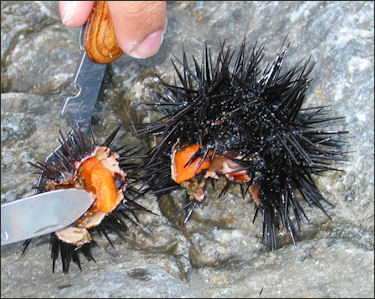
Sea urchin eggs There are 10 uni-producing region in Japan. The uni from each region being a little different. The west coast of Hokkaido is the main uni-producing area in Japan. Much of the sea urchin sold in Japan comes from California, Oregon and Maine. Sea urchin supplies have been so badly depleted in Japan that uni fishermen are only allowed to fish in Japanese waters two hours a day.
Sea urchin divers in southern Australian , who dive in waters filled with great white sharks, earn up to $2,000 a day.
Some domestically-produced sea urchin comes from Miyagi Prefecture. Some measure 15 centimeters across and are said to be at their best when they are harvested in June. Boats set out at 5:00am and fishermen search for the sea creatures using wooden boxes with glass bottoms, Fishermen use poles, which have hook on the front edge, to pick up and drop sea urchins in a basket under the water. The uni harvesting season lasts from June to August.
Red sea urchins are hand-harvested individually by divers off California..According to Business Insider They can be found on seabeds in Santa Barbara, California. The amount of kelp in the water affects how many good-quality urchins can be harvested. When there is a lack of kelp, the urchins are less marketable. Once all of the urchins have been collected, they're sent to a processing facility. Here, the intestines and the sex organs are carefully removed to preserve their freshness. It is crucial not to rip any part of the sex organ, or they drop in value and grade. Farming uni hasn't been perfected yet, so it remains a highly sought-after seafood.[Source: Business Insider, Alexandra Appolonia Nov 3, 2022]
Hatchery-Raised Sea Urchins Clean Up Seaweed-Choked Kaneohe Bay in Hawaii
In the early 2010s, the patch reefs in Kaneohe Bay were in pretty sad shape — smothered and getting choked out by an invasive seaweed species introduced decades before. The The Honolulu Star-Advertiser reported: “Today, it's a different story in the bay. Most of those reefs are pretty healthy and largely clear of the marauding algae, thanks in large part to a unique bio-control program started by the University of Hawaii at Manoa Pacific Cooperative Studies Unit and the state Division of Aquatic Resources. [Source: Timothy Hurley, The Honolulu Star-Advertiser, March 8, 2021]
“It was 10 years ago that the first hatchery-raised sea urchins were released into Hawaii's largest sheltered body of water, left to munch and mow down the seaweed like goats in a grass field. To date, the sea urchin bio-control project has treated more than 227 acres of reef in Kaneohe Bay and has recently expanded to the Waikiki Marine Life Conservation District to control invasive algae.
“Funded by the National Oceanic and Atmospheric Administration and the state, the hatchery has produced more than 600,000 sea urchins that have been released into the wild. “This is one of the most effective marine invasive species control projects implemented in Hawaii, " said Shaya Honarvar, director of the university's Pacific Cooperative Studies Unit. The collector urchins (Tripneustes gratilla ) are spawned, settled and raised at the state's Anuenue Fisheries Research Center at Sand Island.
“Parent urchins are collected from local reefs and taken to the hatchery to spawn. At any given time, the facility is occupied by as many as 15 million urchins in various stages of life, including some 20,000 to 60,000 young urchins earmarked for out-planting. After about 26 days growing from larvae to urchin, they are moved into horizontal tanks lining the interior of the hatchery. After four to six months, the urchins are trucked to a boat for placement on reefs.
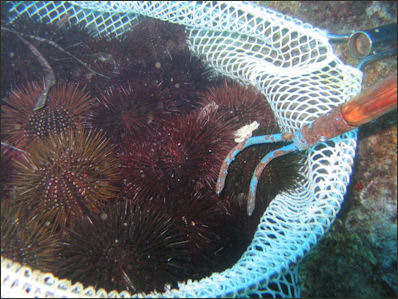 “Kaneohe Bay is home to one of the only barrier reef systems in the United States, offering shelter for a wide variety of aquatic wildlife. But the corals in the bay were ailing, under attack from non-native seaweeds brought to Hawaii in the 1970s for experimental aquaculture projects that were later abandoned. The seaweed escaped and spread throughout the bay. Before the hatchery was created, two types of invasive macroalgae — Kappaphycus and Euchuema — grew in thick mats on top of reefs in Kaneohe Bay, blocking sunlight, killing coral and reducing the watery habitat's ability to produce fish and marine life. “Some places it was 2 or 3 feet deep, " David Cohen, head of the hatchery, said of the seaweed. It was so thick that divers would first have to remove the algae, scooping it up in thick mounds before feeding it into a suction pump mounted on a barge nicknamed "The Super Sucker."
“Kaneohe Bay is home to one of the only barrier reef systems in the United States, offering shelter for a wide variety of aquatic wildlife. But the corals in the bay were ailing, under attack from non-native seaweeds brought to Hawaii in the 1970s for experimental aquaculture projects that were later abandoned. The seaweed escaped and spread throughout the bay. Before the hatchery was created, two types of invasive macroalgae — Kappaphycus and Euchuema — grew in thick mats on top of reefs in Kaneohe Bay, blocking sunlight, killing coral and reducing the watery habitat's ability to produce fish and marine life. “Some places it was 2 or 3 feet deep, " David Cohen, head of the hatchery, said of the seaweed. It was so thick that divers would first have to remove the algae, scooping it up in thick mounds before feeding it into a suction pump mounted on a barge nicknamed "The Super Sucker."
“The urchins would then be planted in a space where they could do their thing, paving the way for coral to regrow and allow for open spaces for fish, native seaweed and invertebrates to use as habitat. While a 2018 UH study found that native sea urchins had successfully reduced the invasive, reef-smothering macroalgae by 85 percent, Cohen said he and others have seen patch reefs where most, if not all, of the invasive seaweed is gone. “Building on the success at Kaneohe Bay, the Division of Aquatic Resources last year began out-planting hatchery-raised urchins in the Waikiki Marine Life Conservation District.
Image Sources: Wikimedia Commons, NOAA
Text Sources: Animal Diversity Web (ADW) animaldiversity.org; National Oceanic and Atmospheric Administration (NOAA) noaa.gov; Wikipedia, National Geographic, Live Science, BBC, Smithsonian, New York Times, Washington Post, Los Angeles Times, The New Yorker, Reuters, Associated Press, Lonely Planet Guides and various books and other publications.
Last Updated May 2023

